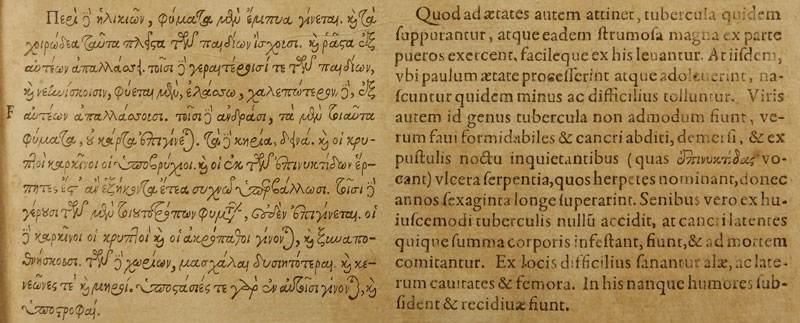
Translation
Regarding ages, pus-producing tumors (όγκοι) and swollen (inflamed) nodes are very often observed in children and are cured easily; in adolescents and young people, these appear more rarely and are cured with difficulty. In adults, these tumors are almost never observed, however, we must be afraid of the skin diseases, the hidden and internal cancers (καρκίνοι), the “herpes-like bloody blisters” or the “dark-color skin eruptions” (επινυκτίδων έρπητες), until they overpass the 60th year of age. In old people, such tumors are not observed, they are, however, afflicted by hidden cancers until they die. Among the various parts of the body, therapy is more difficult for the armpits, the ribs and thighs, because edemas and recurrences appear there.
The word “cancer” originates from the ancient greek word “καρκίνος” (crab; cancrum in latin) first mentioned by Hippocrates (450-370 B.C., Kos, Greece) to describe tumors. Benign tumors were described as “καρκίνοι” (cancers) and malignant (non healing) as “καρκινώματα” (carcinomas). These terms are mentioned seven times in the Works of Hippocrates, accompanied by accurate descriptions and therapeutic methods. Here is a fragment (Praedictorum Lib.B95 F 3) of the Hippocratic text describing cancer.
From: Magni Hippocratis Medicorum Omnium Facile Principis, Opera Omnia Quae Extant, in VIII Sectiones ex Erotiani mente distributa. Nunc denuo Latina Interpretatione et Annotationibus Illustrata. Anutio Fœsio Mediomatrico Medico Authore (1528-1595). Francofurtii (Frankfurt) In Officina Danielis ac Dauidis Aubriorum et Clementis Scleichii, Anno M.DC.XXIV (1624), pp1390.
This book belongs to the collection of old medical books at the International Institute of Anticancer Research.
| Title page | Hippocratic Oath | Contents |
